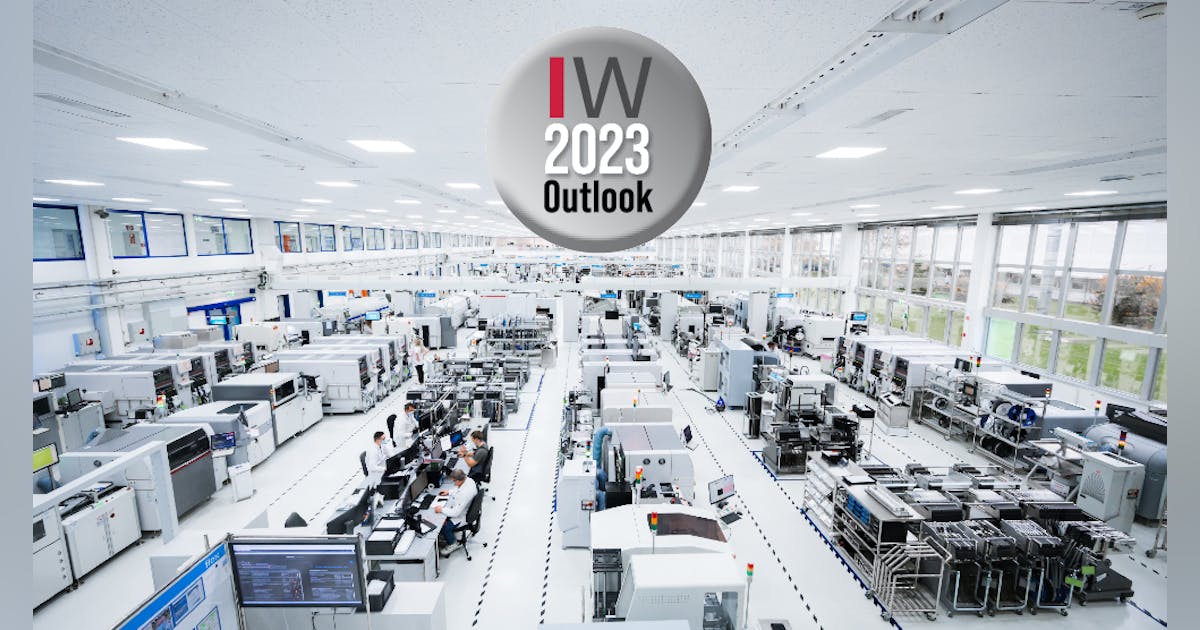Where Manufacturing Technology Goes in 2023: Part 1

[ad_1]
Editor’s Note: Part 1 of 3. IndustryWeek Technology Editor Dennis Scimeca spoke to a wide variety of manufacturing technology experts about what to expect in 2023. Today, read about their thoughts on IIoT/Industry 4.0. Expect Part 2 on additive manufacturing on Dec. 27 at 2 p.m. Eastern. And Part 3, automation and technology for sustainability, runs Jan. 3, 2023, at 6 a.m. Eastern.
Technological development at its best provides rapid and fundamental change, entirely new theories and hardware and conceptual thinking that open new possibilities and pave the way for more rapid and fundamental change.
Those giant leaps are few and far between, however. At its usual pace, technological development happens at a glacial, incremental pace. And that better describes the manufacturing technology world in 2022. We didn’t see any revolutionary innovations or game-changing strategies, rather the evolution of established technologies like additive manufacturing, IIoT and the rest.
So we asked our cavalcade of industry experts what they expected to see in the world of manufacturing technology in 2023. Will we see any giant leaps forward or a continued slow but steady progression of learning how best to use established technologies?
Getting Smarter About Smart Manufacturing
Generally speaking, the idea of a smart factory revolves around information gathering and analysis, with the most “intelligent” factories generating digital twins that allow for a granular understanding of process and the ability to run accurate simulations and forecast the result of changing conditions like delayed supply chains or to predict maintenance cycles.
“When we talk about digital evolution, smart manufacturing, industry 4.0 or Internet of Things the common factor is data. Whether coming from simulations or sensors, today the challenge is not about having data available; it’s more about efficiently and effectively using it,” says Livio Mariano, director of Math and Systems at Altair.
“Digital Twins will be increasingly adopted to process sensors data coming from the field and turn it into a readable form by unveiling or augmenting the information contained in it—e.g., calculating theoretical key performance indicators (KPIs), correction actions, detecting anomalies in the system,” says Mariano.
“Smart factory initiatives unlock new horizons,” says Jason Bergstrom, Smart Factory Go-to-Market leader at Deloitte Consulting. “While companies have been using artificial intelligence and machine learning (AI/ML) on customer sentiment and quality control, implementing it on the factory floor will be key to providing insights and capabilities needed to make their factories more predictive, adaptable, efficient and competitive.
“[In 2023], many companies will begin using or enhancing their usage of digital twins to represent the factory’s product and production systems and reduce the time and cost associated with assembling, installing and validating those systems to ensure they are making timely and insightful decisions based on finances and consumer demand,” Bergstrom continues.
“Data scientists [will] flock to the factory. The factory of the future is digitized, connected, automated and powered by next-gen sensors and tech. But that’s not the reality for every manufacturing organization today,” says Hooi Tan, president of Global Operations and Supply Chain at Flex.
“In 2023, data scientists, engineers and architects will be the most critical factory workers around. These employees will be instrumental in laying the infrastructure to digitally transform the factory and connect it to other aspects of the business, such as the supply chain, so leaders can draw actionable insights from machinery and make impactful business decisions,” says Tan.
“Large enterprises spent 2022 scaling IoT/IIoT investments, solving for and scaling incremental use cases (benefits) as they leveraged the insights from various digitalization initiatives,” says John Lytle, director, manufacturing, with global technology research and advisory firm ISG. “Moving into 2023, a growing focus will be around leveraging digital twins for products and plants for predictive maintenance and performance monitoring. Digital threads will connect the full value-chain of engineering to production to aftermarket services.”
“We may see more advancements in connectivity technologies that allow robots and machine vision systems to connect and interact safely on the factory floor,” says Matthias Thoma, robotics system manager at TI industrial systems. “Design engineers enable IoT connectivity by connecting more devices and machines together, allowing constant monitoring of data from the smallest sensor to CNC machines and industrial robots.”
“Smart manufacturing will continue its current growth and the demand will increase for cloud-based digital manufacturing that is hardware-agnostic and technology neutral,” says Reji Puthenveetil, executive vice president of Industrial Solutions at 3D Systems.
“It is the energized adoption of emerging smart manufacturing technologies that will be the story for 2023,” says Paul Rogers, president and CEO of the Americas at Hexagon AB’s Hexagon Manufacturing Intelligence division. “In the past, a supplier customer would not seriously consider a new software platform or metrology solution until they could verify their OEM customer was also a user. In the new paradigm shift, conventional suppliers are now taking the initiative to be the first company on the block to implement and leverage advances in automation, simulation and metrology. Data-driven solution integrations translate to a head start and a competitive edge when competing with more nimble start-ups.”
Embracing the New (Even if We Don’t Need it)
Even if incremental improvements and gradually increasing rates of adoption defined manufacturing technology in 2022, that’s not to say it’s a downer for enthusiasts. A slow and steady advance arguably makes more sense than taking risks on giant leaps.
“The companies that will thrive in the next wave of the digital economy won’t be the ones clamoring over the shiniest new technologies, such as AI, crypto or Web3. New inventions capture our attention, but innovation is doing something in a new way that generates value. Using something that’s been around for a while can be even more innovative than using something that has just been invented,” says Scott Varho, chief evangelist at 3Pillar.
“Organizations that will thrive in 2023 won’t build technology for technology’s sake. They will assess their target market(s) to determine the why behind the technology, test their hypotheses in a low fidelity, lean way and ultimately understand where the value lies,” Varho says.
[ad_2]
Source link







